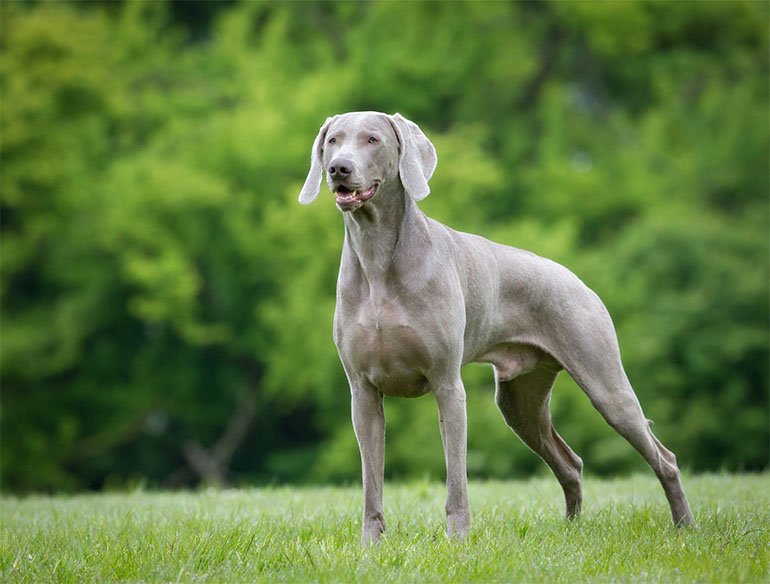Even with their gigantic size, large breeds like the Great Dane are enjoying more love from apartment dwellers.
If you live in a busy city and often stroll through different neighborhoods you may be surprised to see the different breeds you encounter along the way. Not too long along cities were reserved for only small dogs, mainly because of smaller living spaces, but this is no longer the case.
This has probably led many of you to wonder if there are other suitable breeds for smaller homes.
Although owning a dog in an apartment is a big responsibility, however, the reward is well worth it.
Although some breeds of dog might not mix well with tiny living spaces because of their high activity level and noisiness, many are adapted to living in small apartments.
In this article, you will learn the difference between raising dogs in apartments versus traditional home. We will also explore 5 large breeds that are not only suitable for apartments but also ideal companions. Let get started!
Raising a Dog In an Apartment vs. Traditional Home
Living with a giant breed in an apartment is not the same as having one in a traditional home.
You don’t have a wide playing ground and your dog is enclosed in the building for the greater part of the day. Knowing the subtle differences between rearing a big hound in a traditional home and an apartment setting will save you the risk of making costly mistakes.
Raising a Large Dog In an Apartment
When you are sourcing for your dog, you need to consider such things as the size, activity and noise level.
Many landlords will welcome your request if you are convincing enough that your dog is a natural apartment dweller.
Some large dogs tend to do well — many are happy and healthy in apartments such as the Mastiff, Great Danes, St. Bernard, Newfoundland, and Great Pyrenees, however, many others are not suitable for a small living space. However, for some dog owners, particularly those of mutt puppies it is sometimes difficult to predict just how large your pet will be when they’re fully grown.
The example mentioned here are some of the couch potatoes of the dog world — they can nap all day long on your couch. They live well in apartments setting and only need to go outside regularly to stretch their legs. If you have a nearby dog park near your home, these places can help with their exercise and they will get to meet other dogs too.
Living In Traditional Home
Usually, there is not a lot of restraint as to living with large breeds. There is a wide space and lots of playing ground. Except for a few disinterested neighbors, you have a lot more freedom taking in a big hound.
In this case, all the dog needs is a safe and secure area with a good shelter inside or outside the barn. The dog can live outside even in winter and doesn’t need a crate.
It’s easy to go on daily works than when you are living in an apartment. The only thing you will need is lots of handling and training.
When bringing a dog into your apartment, there are a couple of things you need to ensure are in place if you want to create harmony between you and your dog:
- Train your dog to be home alone, even if it’s attention seeking
- Set rules and guidelines for your dog to follow, where to sleep – is it on the sofa, can they claim a pillow beside you on the bed, or be on their spot on the floor?
- Make sure dogs are permitted by your landlord.
- The environment is dog-friendly, not somewhere the dog can easily jump out of the balcony
So, what are the best large dogs for apartments?
Mastiff
The Mastiff is a quiet family dog that was initially trained as a guard dog. This dog can weigh up to 150 pounds and their size can look imposing.
Fortunately, the size doesn’t matter as it doesn’t prevent the Mastiff from living in an apartment. Since this pup can snooze a greater part of the day, a small living space is okay for them. And they have low activity level so daily walks put them in a good mood.
Because they are so lazy, they are good apartment dwellers. They are happy once they have a place to nap. The only problem you might face is if you landlord will accept a dog of this size. You may have to discuss with your him to see if you can bring this guy in.
Great Danes
This dog is among the less active breeds in the dog world with an overwhelming size. Even with its gigantic size, it’s referred to as a gentle giant.
It is very sociable usually thinking they are like people and not dogs so they may want to live with you more than go out in the wild. They are social animals and are known to be friendly towards other animals, even cats. If you are looking to train them, you will find them highly trainable.
Although they are a loafer, you’ll want to Dane Proof your house. If you are living in a tiny apartment and have lots of unbreakable, it may be a little difficult to house a Dane because they can easily break things. You wouldn’t have any problem at all if you can Dane proof them though.
Another thing to be aware of: while they are low energy hounds, you need to give them regular exercise and many owners have found that daily walks seem to satisfy them. For a dog of their size (usually weighing more than 120 pounds), Great Danes don’t need a big couch or a big space to live.
St. Bernard
This dog started out as an avalanche rescue dog but has quickly become one of the few breeds suitable for apartment owners. Their foundation as a rescue dog gives the great strengths, which makes them a good worker.
Unlike the Mastiff and Great Danes of this world, they are not lazy. They are more active although social, especially with other dogs. Because of this, they’ll need a lot of exercise. If you don’t think you can take it out twice a day to stretch the legs, then you may want to look at the other breeds in this list for those that have lower activity level.
The St. Bernard hound has a body that’s sensitive to heat, so it’s not a friend of the summer. So, if you live in an area where it is hot most of the time, you’ll find they might not be suitable. They love snow and good winter months, so if you can house them in an area where they can enjoy either of this two, then you’ll win their heart.
Also, the St. Bernard is Velcro dogs, so it’s happy at your feet when not out playing. To keep it active indoors, you can get them toys and bones to keep they can play with.
Newfoundland
This is one of the powerful but docile puppies on this list. They are gentle, social, and can make great companions. This breed doesn’t need a lot of space — they will lounge around or sleep in the apartment. Even with that, they love to go out but don’t require a lot of exercises.
Most apartment dwellers have found great companionship in them because they are calm and well behaved and always willing to please. One caveat: they are large and first floor apartments are best for them because they are not good with stairs. Moreover, they are similar to the Great Danes because of their laid back personality. And like the St. Bernard, they are not afraid of the cold winters and can stay indoors for long – as long as they have you, they are happy.
Great Pyrenees
The Great Pyrenees looks imposing but gentle. They are wary of danger but affectionate towards family. In fact, they like to protect sheep, goat, and livestock from predators, which makes them one of the best you can get if you intend using it for some sort of protection.
Great Pyrenees have a strong build and they are elegant, beautiful and majestic. However, you have to train them because if you don’t they can become uncontrollable. Don’t let this scare you though, they are easy to train. All you’ll need consistency, patience, and possible reinforcement.
Start with socialization early and let them out to see other dogs or animals so they don’t become aggressive or fearful. Your neighbors will also like them because they are calm, patient, smart and affectionate.
With proper training, they will easily tolerate non-family members into your apartment sometimes without your permission. However, intruders are mostly unwelcome. This breed has a sensitive hearing and can detect intruders even with the closed windows and air conditioners, TV, refrigerators running.
How To Keep Your Dog in Good Shape When Living in an Apartment
There are many things you need to look into when living with your dog. However, a few things need to be done because they are very important and will decide whether your experience is awesome or not so cool:
- It’s important to communicate with your landlord about your hound to discuss specific requirements such as size and breed
- Keep them on vaccination if you want them running around the yard and be courteous of your neighbor
- Devote time to your dog
- Do house training
Conclusion
If you live in a small space in a city, it shouldn’t deter you from adopting one of these breeds. All you have to do is understand your pooch – with the help of this article – and your living space. All you need is a balanced equation and you’d be out having an awesome experience.

